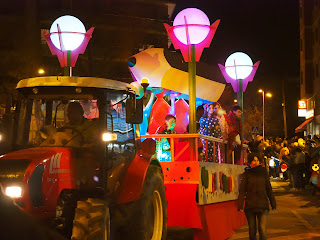Cupcake
was a little black dog with some tan highlights, a Tibetan Spaniel
who weighed seven quilos and who changed my life.
When
I came to live in Figueres with Minnie and Felix, I didn’t know a soul.
I adopted Cupcake after I had been here for two years and he changed
all that. After about two weeks, I took him to the dog park so he
could socialize and within a short time we both had a group of
friends. Eight years later, some of them are still friends.
I
had wanted a dog all my adult life, but there had been reasons why I
didn’t feel I could responsibly adopt one. Finally, I owned my own
apartment, I had no disapproving husband, and I was free to do what I
wanted.
What
I wanted was an older dog. For one thing, I was older and didn’t
see myself running around, coping with the energy of a puppy. I also
didn’t want it to be likely that my dog would outlive me. If so,
who would take care of him? Animal groups say that most people want
puppies or young dogs and the seniors – the ones who have the
hardest time living in an animal shelter and need adoption the most –
get left behind. Well not by me. I would take in one of those
seniors and make a comfortable home for him or her. As the saying
goes, “Saving one dog will not change the world, but surely for
that one dog, the world will change forever.”
Canae
was the rescue group that contacted me; they had a senior seven years
old that needed fostering. My vet later said he was more likely nine
years old when they brought him, on the 15th of January
2015, the day of his surgery. He was at a shelter, it was winter,
and the group didn’t want him to have to recover in a cage.
We
called it fostering, but I knew that if he and the cats would
tolerate each other, he would stay. Felix had chronic health
problems and the vet thought introducing a dog to the household would
be stressful for him and bad for his health. Felix, a gregarious
cat, took to him immediately and made a nuisance of himself. Minnie,
a bit aloof, didn’t really give a damn and mainly ignored him.
Cupcake wasn't a cat fan, but he gave them space and didn’t
seem frightened of them. He stayed.
Cupcake
was a stoic dog. They had told me that he was a Pekingese mix, but
one look at the breed chart at the vet and it was clear that he was a
Tibetan Spaniel. No one seems to know that breed here; I don’t
think I’ve ever seen another one. Tibetan Spaniels were bred to
guard Buddhist temples. They are Zen. Cupcake was Zen.
For
the first few weeks he was here, he never made a peep of any kind. I
began to wonder if his vocal chords were damaged. But then one day
he let loose one bark at a dog that was annoying him. So he wasn’t
damaged, he was just very quiet. And he was no patsy.
Our
first day at the dog park someone recognized him from the photo the
rescue group had posted. Cupcake was famous!
The
dog park (pipican, as they call it) became a daily thing. Morning
was to the fountain, where he liked to poop on the grass, evening was
to the pipican where he sniffed around and ran with the other dogs.
Seeing this short little dog running circles around the park with all
kinds of dogs including a couple of greyhounds was a sight to behold.
It
was at the dog park that I met what became most of my friends. The
dog park crowd and the people I met around town while I walked my dog
and they walked theirs, are the people who became my community –
some became friends, others acquaintences to chat with on the street.
Cupcake
loved the dogpark. After a while he ran less and sniffed more. It
didn’t take long before he discovered that some of the owners
brought treats with them. So he began to hang out more at the
benches where the treats were. Eventually he only hung out at the
benches. When new people started to come with big dogs, some of whom
were aggressive, we stopped going.
When
I first moved to Figueres I looked for where I could take a walk from
my home into the countryside without having to use my car, and I
found a path that went from Figueres to the nearby village of
Vilabertran. From home it was about an hour’s walk to the village.
I did that walk by myself from time to time. Soon after I adopted
Cupcake I took him. He was a small dog and a senior, so I wasn’t
sure if he could do it, but he had no problem. Two hours of walking
and he didn’t want to come home. He loved it.
Soon
after we started walking that path, I was invited to join two of the
men from the dog park. They regularly did that walk with their dogs.
The six of us soon became a regular thing. Josep and Keti the
border collie, Jaume and Pluto the schnauzer, and me and Cupcake the
Buddhist monk. We would do the walk together three times a week, and
Cupcake and I would do it on our own a fourth time on the weekend.
They were the ones who convinced me that I could let Cupcake off his
leash. He might explore a little bit, but he wasn’t going to go
anywhere, Josep said. The first time off leash he was off into the
fields. I almost had a heart attack. I called and called, I was
frantic. But he came back after a few minutes and I never had
another problem. I guess he was just celebrating his good luck.

Eventually
our little walking group fell apart, but Cupcake and I continued. He
couldn’t do the walk in the summer when it was too hot, but we did
it the rest of the year and as he got older and walking was more
difficult, I would drive to a closer starting point so we could cut
out the city part and just enjoy the country path where he could go
off leash.
Cupcake
was unique in several ways, not least of them his being the only
Tibetan Spaniel in town. With the few exceptions when some other dog
wouldn’t remove his nose from you-know-where, he never barked. He
also didn’t wag his tail very often. He didn’t give kisses, but
he snorted like a horse; that was his way of showing pleasure.
Cupcake’s
greatest pleasures were walking, especially off leash in the country,
going to the beach, and eating treats. He didn’t like the car, but
he came to understand that it was necessary in order to get to what
he did like. He hesitated, but he never complained.
In
2019, when he was about 13, he started to have noticeable back,
shoulder, and joint pain. Medication helped, but there are side
effects to pain killers and I didn’t want to rely on that long
term. My friend Marc suggested acupuncture. There was a vet in
Girona who specialized in acupuncture for dogs and cats, so he drove
us to see her.
Once
again Cupcake’s stoicism won the day. He would sit calmly while
Laia applied the needles and continued to calmly wait (more or less)
until it was over. The monthly acupuncture sessions helped a lot.
Homeopathic medicines also helped so that although he still had some
pain, it wasn’t acute and I judged that his quality of life was
good.
Except
during summers, during his last two years we kept doing abbreviated
walks where he could go off leash: along the Muga River, visits to
the beach, and most often, the Vilabertran walks. That path is one
branch of the Camino de Santiago de Compostela. Cupcake loved
walking out there; he was my little pilgrim.
Although
summer heat limited activity, we could go to a park and poke around
in the evening shade – a change of pace from our evening walks in
town which had become boring because he couldn’t go far. I would
drive us to one of three close-by parks and let him sniff all he
wanted and socialize with other dogs if he felt like it.
Cupcake
developed congenital heart disease, dementia, and the ongoing back
and joint pain, but he never complained. But from the way he walked,
I could tell he was having a hard time. Towards the end the
acupuncture no longer seemed to make much difference and neither did
those homeopathic medicines. He was still eating and enjoying
treats, he still wanted to go out, but once out, he had a hard time
and no longer even sniffed much as he walked, as if he needed to
concentrate just on putting one foot in front of the other. I live
on the second floor (would be the third in the U.S.) and there is no
elevator. Stairs had become difficult for him, but I was no longer
in condition to carry him up and down.

Cupcake’s
acupuncturist had given me a canine quality of life form that I used
for measuring his quality of life, and this time it came out poor.
He wasn’t ill. I knew he could still go on, but at what price? I
had made a promise to myself that when the time
came I would let him go. I had learned from other pets the mistake
of holding on for too long for my own sake.
We were together for eight years. He brought me more joy than I can say. He was the most
beautiful dog. I never got tired of looking at him. I took thousands of photos; we took
thousands of walks. He was my best pal. He was the perfect dog for
me.
I had Cupcake put to sleep on 8 May 2023. I held him in my arms as he fell asleep and then as he passed away. He didn't feel a thing, but I suffered one of the greatest pains of my life. And yet it wasn't that hard a decision. I knew the time that I had been dreading had come.
I buried some of his ashes near the Vilabertran path that he loved; the rest I have here at home with me together with the ashes of Minnie and Felix. I imagine his spirit is out
there somewhere taking lovely walks and being quiet, calm, and happy.











.jpg)




































